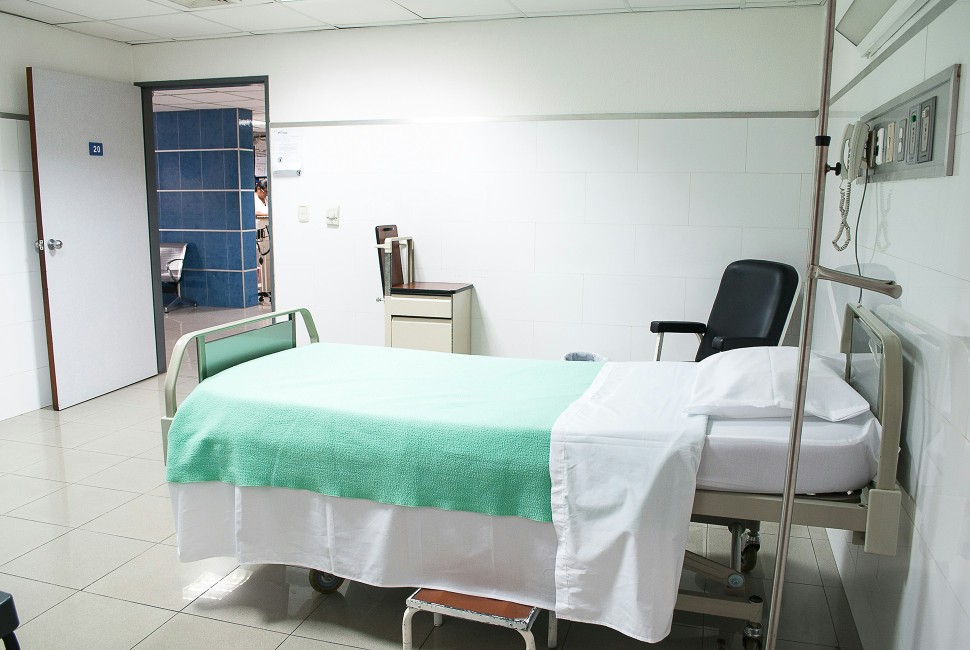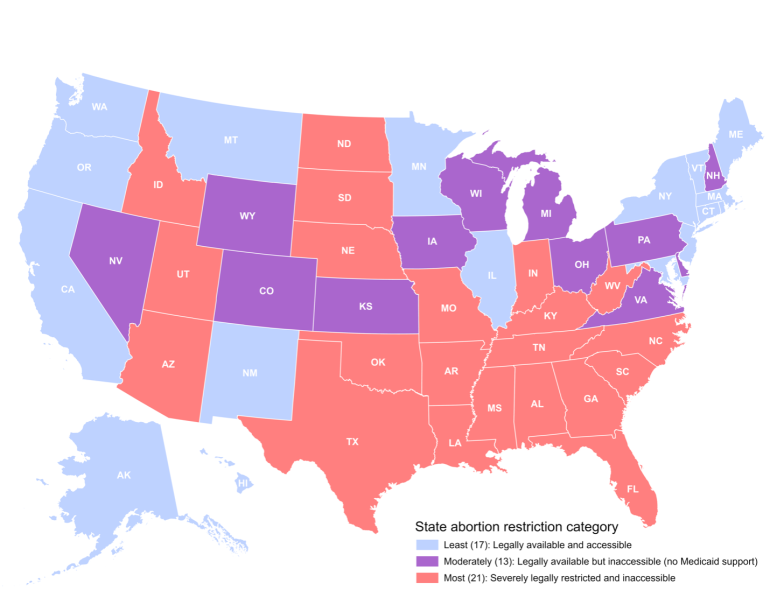'Pro-life attitude begins at conception but ends there as well'
September 4, 2024 | By Kristin Samuelson

States with the most severe post-Dobbs abortion restrictions also have the fewest policies in place to support raising families, reports a new Northwestern Medicine study.
States with the most severe post-Dobbs abortion restrictions also have the fewest policies in place to support raising families, reports a Northwestern Medicine study, published Sept. 4 in the American Journal of Public Health.
“We found that in the states that most severely restrict abortion, the women, children and families that abortion proponents seek to ‘protect’ are the populations that are left behind — with less access to health care and family social services — when pregnancy is continued,” said lead and corresponding author Dr. Nigel Madden, a recent graduate of the fellowship in maternal-fetal medicine at Northwestern University Feinberg School of Medicine and now an instructor at Harvard Medical School and physician at Beth Israel Deaconess Medical Center.
This is one of the only academic studies to systematically examine the intersection between post-Dobbs state abortion policy and state access to reproductive health care and family social policies and programs.
“Proponents of abortion restrictions, who identify as ‘pro-life,’ assert that these policies are essential to protect children, women and families,” said senior author Dr. Lynn Yee, associate professor of obstetrics and gynecology at Feinberg and a Northwestern Medicine physician. “It would seem in these states that the abortion-opponent, ‘pro-life’ attitude not only begins at conception but ends there as well.”
Certain groups disproportionally bear a greater burden from abortion bans, the study authors said. Previous research has found that people of low socioeconomic status and marginalized people are more likely to seek abortion, and they’re also less likely to be able to overcome barriers imposed by abortion bans and restrictions, such as needing to travel out of state to receive care.
How support is lacking
Compared to the least restrictive states, the study found states with more severe abortion restrictions are:More likely to have lower enrollment in state-funded assistance programs, such as the nutrition-assistance Women, Infants and Children (WIC) program or the Temporary Assistance for Needy Families (TANF) program, because women and families in these states are required to be poorer to qualify for these programs
Less likely to implement policies that support families, such as paid family leave. Of the states with the most restrictive abortion bans, none have a mandatory paid family leave policy
More likely to limit access to reproductive health care
Less likely to have policies in place that allow for pharmacists to prescribe birth control (42.9% vs. 82.4% of the least restrictive states)
“The degree to which these states fail to support their most disadvantaged populations warrants immediate attention and action,” said co-author Katie Watson, professor of medical education, medical social sciences and obstetrics and gynecology at Feinberg.

It would seem in these states that the abortion-opponent, ‘pro-life’ attitude not only begins at conception but ends there as well.”Dr. Lynn Yee
“Advocates should take this opportunity to leverage the child protection arguments of anti-abortion policymakers and encourage them to put their money where their mouth is by advocating for the implementation and improvement of policies that support individual and family well-being.”
This might include adding new policies like postpartum Medicaid expansion or paid family and medical leave; increasing eligibility for state-based assistance programs like WIC and TANF or creating new programs like mobile health clinics to serve pregnant people in maternity care deserts, the study authors said.
Breakdown of abortion restrictions by state
The study categorized states into three post-Dobbs abortion-restriction groups based on state abortion policies as of December 2023:

States with the most severe post-Dobbs abortion restrictions also have the fewest policies in place to support raising families, reports a new Northwestern Medicine study.
States with the most severe post-Dobbs abortion restrictions also have the fewest policies in place to support raising families, reports a Northwestern Medicine study, published Sept. 4 in the American Journal of Public Health.
“We found that in the states that most severely restrict abortion, the women, children and families that abortion proponents seek to ‘protect’ are the populations that are left behind — with less access to health care and family social services — when pregnancy is continued,” said lead and corresponding author Dr. Nigel Madden, a recent graduate of the fellowship in maternal-fetal medicine at Northwestern University Feinberg School of Medicine and now an instructor at Harvard Medical School and physician at Beth Israel Deaconess Medical Center.
This is one of the only academic studies to systematically examine the intersection between post-Dobbs state abortion policy and state access to reproductive health care and family social policies and programs.
“Proponents of abortion restrictions, who identify as ‘pro-life,’ assert that these policies are essential to protect children, women and families,” said senior author Dr. Lynn Yee, associate professor of obstetrics and gynecology at Feinberg and a Northwestern Medicine physician. “It would seem in these states that the abortion-opponent, ‘pro-life’ attitude not only begins at conception but ends there as well.”
Certain groups disproportionally bear a greater burden from abortion bans, the study authors said. Previous research has found that people of low socioeconomic status and marginalized people are more likely to seek abortion, and they’re also less likely to be able to overcome barriers imposed by abortion bans and restrictions, such as needing to travel out of state to receive care.
How support is lacking
Compared to the least restrictive states, the study found states with more severe abortion restrictions are:More likely to have lower enrollment in state-funded assistance programs, such as the nutrition-assistance Women, Infants and Children (WIC) program or the Temporary Assistance for Needy Families (TANF) program, because women and families in these states are required to be poorer to qualify for these programs
Less likely to implement policies that support families, such as paid family leave. Of the states with the most restrictive abortion bans, none have a mandatory paid family leave policy
More likely to limit access to reproductive health care
Less likely to have policies in place that allow for pharmacists to prescribe birth control (42.9% vs. 82.4% of the least restrictive states)
“The degree to which these states fail to support their most disadvantaged populations warrants immediate attention and action,” said co-author Katie Watson, professor of medical education, medical social sciences and obstetrics and gynecology at Feinberg.

It would seem in these states that the abortion-opponent, ‘pro-life’ attitude not only begins at conception but ends there as well.”Dr. Lynn Yee
“Advocates should take this opportunity to leverage the child protection arguments of anti-abortion policymakers and encourage them to put their money where their mouth is by advocating for the implementation and improvement of policies that support individual and family well-being.”
This might include adding new policies like postpartum Medicaid expansion or paid family and medical leave; increasing eligibility for state-based assistance programs like WIC and TANF or creating new programs like mobile health clinics to serve pregnant people in maternity care deserts, the study authors said.
Breakdown of abortion restrictions by state
The study categorized states into three post-Dobbs abortion-restriction groups based on state abortion policies as of December 2023:

Most restrictive group: Includes 21 states in which abortion is severely restricted, 14 of which have complete abortion bans with very limited exceptions and 7 of which have an early gestational age ban of 6–18 weeks’ gestation
Moderately restrictive group: Includes states in which abortion is legally available, but Medicaid coverage of abortion is prohibited, making abortion largely inaccessible to a significant portion of the population. These states also often have additional restrictive and burdensome policies (i.e. waiting periods, mandatory parental notification for monitors, etc.) in place
Least restrictive group: Includes states in which abortion is both legally available and accessible. These states have either no gestational age ban or ban abortion at 24 weeks’ gestation or later and allow Medicaid funds to pay for abortion
Moderately restrictive group: Includes states in which abortion is legally available, but Medicaid coverage of abortion is prohibited, making abortion largely inaccessible to a significant portion of the population. These states also often have additional restrictive and burdensome policies (i.e. waiting periods, mandatory parental notification for monitors, etc.) in place
Least restrictive group: Includes states in which abortion is both legally available and accessible. These states have either no gestational age ban or ban abortion at 24 weeks’ gestation or later and allow Medicaid funds to pay for abortion
No comments:
Post a Comment